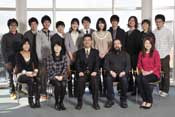Kouichi Asakura, Professor, Faculty of Science and Technology
Chemical Study of “lively” behavior of life forms
We analyze from a chemical standpoint the mechanism of lively phenomena in life such as biorhythms, and develop new industrial technology applying the knowledge we obtain.
(8 graduate students and 4 undergraduate students)

There are many things around us that look easy but are actually difficult. For example, “to make a flat surface” may sound easy for anybody, but if you look carefully at the painted surface of a shelf or a door from the sides, you can observe a bumpy pattern in a spatial periodicity of several millimeters. This is called the orange peel phenomenon, and is a structure that occurs spontaneously in the drying process of a painted surface. Also, if you look closely at an aluminum sash, you can observe a stripe pattern in approximately a 0.1mm spatial periodicity. This is a structure that generates spontaneously when processing aluminum.
Generation of such structures becomes a major issue in painting luxury cars, manufacturing DVDs and Blue-ray Discs and coating photoresists, but what helps in developing technology to avoid these problems is surprisingly, the biorhythm of life forms. Biorhythms include temporally periodic structures such as the heartbeat or the sleep-wake cycle, and spatially periodic structures such as body patterns of tigers and tropical fish. Such “lively” phenomena in life do not occur because “life is a special thing created by god”. Based on the concept of “dissipative structure” which was awarded the Nobel Prize in Chemistry in 1977, we can explain the mechanism of biorhythms and create spatiotemporal rhythms by chemical reactions. We can also control the generation of patterned structures that cause problems in the manufacturing process.
In our laboratory, we don’t let “mysteries of life” stay mysteries. We unveil them from a chemical standpoint, and develop new industrial technology applying the knowledge we obtain. Also, through such research process, students learn the concept of “dissipative structure”, and graduate to start a career as a researcher or an engineer. Even after graduation, they maintain a lifelong relationship with our lab through joint researches, exchange of technical information, job hunting and etc. We can say that this is a realization of the “half learning, half teaching” spirit, where graduates, students and teachers learn from each other and teach each other.
Student's Voice
Shunsuke Takayama, First-year Student of Master's Program,
Graduate School of Science and Technology
“Self-Organization” is the keyword
In Professor Asakura’s laboratory, we research on various themes based on the phenomenon called “self-organization”. Although the name of the lab is “Organic” Material Chemistry Laboratory, we don’t limit to organic chemistry, and some students choose performance evaluation of sunscreen or analysis of chemical reaction rates as a research theme. Therefore, through weekly presentations and midterm presentations held 4 times a year, we can obtain scientific knowledge of various research themes not limiting to one’s own theme. Also, through study sessions and lectures in turn, we read English textbooks and learn concepts that stand as the basis of all themes. By teaching each other rather than just being taught from Prof. Asakura, we enhance each other and proceed with our research.
*Position titles, etc., are those at the time of publishing.
